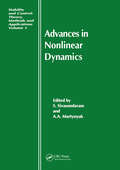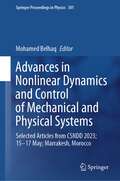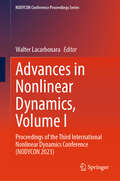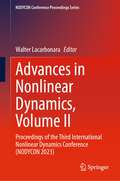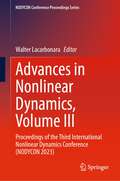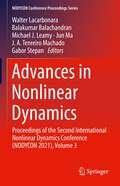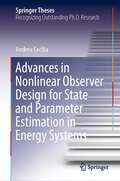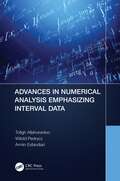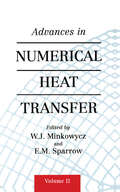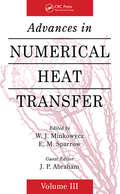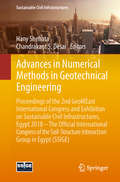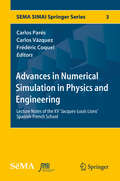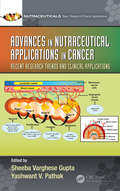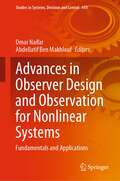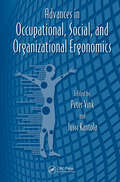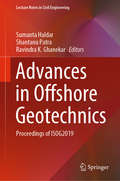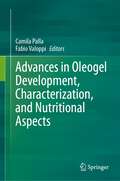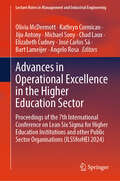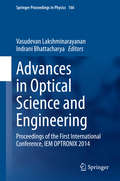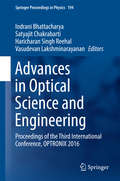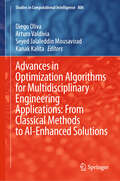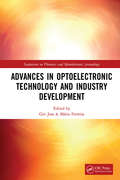- Table View
- List View
Advances in Nonlinear Dynamics
by S. Sivasundaram A. A. MartynyukDedicated to Professor S. Leela in recognition of her significant contribution to the field of nonlinear dynamics and differential equations, this text consists of 38 papers contributed by experts from 15 countries, together with a survey of Professor Leela's work. The first group of papers examines stability, the second process controls, and the third section contains papers on various topics, including solutions for new classes of systems of equations and boundary problems, and proofs of basic theorems. Many of the featured problems are associated with the ideas and methods proposed and developed by Professor Leela.
Advances in Nonlinear Dynamics and Control of Mechanical and Physical Systems: Selected Articles from CSNDD 2023; 15–17 May; Marrakesh, Morocco (Springer Proceedings in Physics #301)
by Mohamed BelhaqThis book highlights recent advances in nonlinear dynamics and control with applications in mechanics and physics. The book includes selected articles from the 5th Conference on Structural Nonlinear Dynamics and Diagnosis (CSNDD 2023) and presents recent theoretical, experimental and numerical findings covering various topics in nonlinear structural dynamics and diagnosis. The main topics includes multiple scales dynamics, energy harvesting, dynamics of MEMS, NEMS and AFM, systems with time delay, quasi-periodic oscillations and synchronization, stochastic dynamics, analytical and semi-analytical methods, time series analysis, control and analysis of switching systems, structural health monitoring, nonlinear vibrations of structures, nonsmouth dynamics, nonlinear phenomena in discrete and continuum systems, dynamic modeling and fault diagnosis, constrained multi-catenary systems, conservative chaotic system, hysteretic structures, and nonlinear PDEs and their dynamics.
Advances in Nonlinear Dynamics, Volume I: Proceedings of the Third International Nonlinear Dynamics Conference (NODYCON 2023) (NODYCON Conference Proceedings Series)
by Walter LacarbonaraThis volume aims to present the latest advancements in experimental, analytical, and numerical methodologies aimed at exploring the nonlinear dynamics of diverse systems across varying length and time scales. It delves into the following topics:Methodologies for nonlinear dynamic analysis (harmonic balance, asymptotic techniques, enhanced time integration)Data-driven dynamics, machine learning techniquesExploration of bifurcations and nonsmooth systemsNonlinear phenomena in mechanical systems and structuresExperimental dynamics, system identification, and monitoring techniquesFluid-structure interactionDynamics of multibody systemsTurning processes, rotating systems, and systems with time delays
Advances in Nonlinear Dynamics, Volume II: Proceedings of the Third International Nonlinear Dynamics Conference (NODYCON 2023) (NODYCON Conference Proceedings Series)
by Walter LacarbonaraThis second of three volumes presents papers from the third series of NODYCON to be held in June of 2023. The conference papers reflect a broad coverage of topics in nonlinear dynamics, both traditionally placed in established streams of research as well as they stand as newly explored and emerging venues of research. These include• Multi-scale dynamics: multiple time/space scales, large system dynamics• Experimental dynamics: benchmark experiments, experimental methods,instrumentation techniques, measurements in harsh environments, experimentalvalidation of nonlinear models• Reduced-order modeling: center manifold reduction, nonlinear normal modes, normalforms• Systems with time and/or space delays• Nonlinear interactions in multi-dof systems: parametric vibrations, multiple external andautoparametric resonances.• Computational techniques: efficient algorithms, use ofsymbolic manipulators, integrationof symbolic manipulation and numerical methods, use of parallel processors.• Nonlinear system identification: parametric/nonparametric identification, data-drivenidentification• Multibody dynamics: rigid and flexible multibody system dynamics, impact and contactmechanics, tire modeling, railroad vehicle dynamics, biomechanics applications,computational multibody dynamics• Fluid/structure interaction• Nonlinear wave propagation in discrete and continuous media
Advances in Nonlinear Dynamics, Volume III: Proceedings of the Third International Nonlinear Dynamics Conference (NODYCON 2023) (NODYCON Conference Proceedings Series)
by Walter LacarbonaraThis third of three volumes presents papers from the third series of NODYCON to be held in June of 2023. The conference papers reflect a broad coverage of topics in nonlinear dynamics, both traditionally placed in established streams of research as well as they stand as newly explored and emerging venues of research. These include• Multi-scale dynamics: multiple time/space scales, large system dynamics• Experimental dynamics: benchmark experiments, experimental methods,instrumentation techniques, measurements in harsh environments, experimentalvalidation of nonlinear models• Reduced-order modeling: center manifold reduction, nonlinear normal modes, normalforms• Systems with time and/or space delays• Nonlinear interactions in multi-dof systems: parametric vibrations, multiple external andautoparametric resonances.• Computational techniques: efficient algorithms, use ofsymbolic manipulators, integrationof symbolic manipulation and numerical methods, use of parallel processors.• Nonlinear system identification: parametric/nonparametric identification, data-drivenidentification• Multibody dynamics: rigid and flexible multibody system dynamics, impact and contactmechanics, tire modeling, railroad vehicle dynamics, biomechanics applications,computational multibody dynamics• Fluid/structure interaction• Nonlinear wave propagation in discrete and continuous media
Advances in Nonlinear Dynamics: Proceedings of the Second International Nonlinear Dynamics Conference (NODYCON 2021), Volume 3 (NODYCON Conference Proceedings Series)
by Jun Ma Walter Lacarbonara J. A. Tenreiro Machado Balakumar Balachandran Gabor Stepan Michael J. LeamyThis third of three volumes includes papers from the second series of NODYCON, which was held virtually in February of 2021. The conference papers reflect a broad coverage of topics in nonlinear dynamics, ranging from traditional topics from established streams of research to those from relatively unexplored and emerging venues of research. These include· Complex dynamics of COVID-19: modeling, prediction and control · Nonlinear phenomena in bio-systems and eco-systems · Energy harvesting · MEMS/NEMS · Multifunctional structures, materials and metamaterials · Nonlinear waves · Chaotic systems, stochasticity, and uncertainty
Advances in Nonlinear Observer Design for State and Parameter Estimation in Energy Systems (Springer Theses)
by Andreu CeciliaThis book reports on a set of advances relating to nonlinear observer design, with a special emphasis on high-gain observers. First, it covers the design of filters and their addition to the observer for reducing noise, a topic that has been so far neglected in the literature. Further, it describes the adaptive re-design of nonlinear observers to reduce the effect of parametric uncertainty. It discusses several limitations of classical methods, presenting a set of successfull solutions, which are mathematically formalised through Lyapunov stability analysis, and in turn validated via numerical simulations. In the second part of the book, two applications of the adaptive nonlinear observers are described, such in the estimation of the liquid water in a hydrogen fuel cell and in the solution of a common cybersecurity problem, i.e. false data injection attacks in DC microgrids. All in all, this book offers a comprehensive report on the state-of-the-art in nonlinear observer design for energy systems, including mathematical demonstrations, and numerical and and experimental validations.
Advances in Numerical Analysis Emphasizing Interval Data
by Witold Pedrycz Tofigh Allahviranloo Armin EsfandiariNumerical analysis forms a cornerstone of numeric computing and optimization, in particular recently, interval numerical computations play an important role in these topics. The interest of researchers in computations involving uncertain data, namely interval data opens new avenues in coping with real-world problems and deliver innovative and efficient solutions. This book provides the basic theoretical foundations of numerical methods, discusses key technique classes, explains improvements and improvements, and provides insights into recent developments and challenges. The theoretical parts of numerical methods, including the concept of interval approximation theory, are introduced and explained in detail. In general, the key features of the book include an up-to-date and focused treatise on error analysis in calculations, in particular the comprehensive and systematic treatment of error propagation mechanisms, considerations on the quality of data involved in numerical calculations, and a thorough discussion of interval approximation theory. Moreover, this book focuses on approximation theory and its development from the perspective of linear algebra, and new and regular representations of numerical integration and their solutions are enhanced by error analysis as well. The book is unique in the sense that its content and organization will cater to several audiences, in particular graduate students, researchers, and practitioners.
Advances in Numerical Heat Transfer, Volume 2: Advances In Numerical Heat Transfer Volume V (Computational And Physical Processes In Mechanics And Thermal Sciences Ser.)
by W. MinkowyczThis volume discusses the advances in numerical heat transfer modeling by applying high-performance computing resources, striking a balance between generic fundamentals, specific fundamentals, generic applications, and specific applications.
Advances in Numerical Heat Transfer, Volume 3 (Computational & Physical Processes in Mechanics & Thermal Scienc)
by W. J. MinkowyczDefinitive Treatment of the Numerical Simulation of Bioheat Transfer and Fluid FlowMotivated by the upwelling of current interest in subjects critical to human health, Advances in Numerical Heat Transfer, Volume 3 presents the latest information on bioheat and biofluid flow. Like its predecessors, this volume assembles a team of renowned internatio
Advances in Numerical Methods in Geotechnical Engineering: Proceedings of the 2nd GeoMEast International Congress and Exhibition on Sustainable Civil Infrastructures, Egypt 2018 – The Official International Congress of the Soil-Structure Interaction Group in Egypt (SSIGE) (Sustainable Civil Infrastructures)
by Hany Shehata Chandrakant S. DesaiThis volume deals with numerical simulation of coupled problems in soil mechanics and foundations. It contains analysis of both shallow and deep foundations. Several nonlinear problems are considered including, soil plasticity, cracking, reaching the soil bearing capacity, creep, etc. Dynamic analyses together with stability analysis are also included. Several numerical models of dams are considered together with coupled problems in soil mechanics and foundations. It gives wide range of modeling soil in different parts of the world. The volume is based on the best contributions to the 2nd GeoMEast International Congress and Exhibition on Sustainable Civil Infrastructures, Egypt 2018 – The official international congress of the Soil-Structure Interaction Group in Egypt (SSIGE).
Advances in Numerical Modeling of Adhesive Joints (SpringerBriefs in Applied Sciences and Technology)
by Lucas Filipe da Silva Raul D. CampilhoThis book deals with the most recent numerical modeling of adhesive joints. Advances in damage mechanics and extended finite element method are described in the context of the Finite Element method with examples of application. The book also introduces the classical continuum mechanics and fracture mechanics approach and discusses the boundary element method and the finite difference method with indication of the cases they are most adapted to. At the moment there a no numerical technique that can solve any problem and the analyst needs to be aware of the limitations involved in each case.
Advances in Numerical Simulation in Physics and Engineering: Lecture Notes of the XV 'Jacques-Louis Lions' Spanish-French School (SEMA SIMAI Springer Series #3)
by Carlos Vázquez Carlos Parés Frédéric CoquelThe book is mainly addressed to young graduate students in engineering and natural sciences who start to face numerical simulation, either at a research level or in the field of industrial applications. The main subjects covered are: Biomechanics, Stochastic Calculus, Geophysical flow simulation and Shock-Capturing numerical methods for Hyperbolic Systems of Partial Differential Equations. The book can also be useful to researchers or even technicians working at an industrial environment, who are interested in the state-of-the-art numerical techniques in these fields. Moreover, it gives an overview of the research developed at the French and Spanish universities and in some European scientific institutions. This book can be also useful as a textbook at master courses in Mathematics, Physics or Engineering.
Advances in Nutraceutical Applications in Cancer: Recent Research Trends and Clinical Applications (Nutraceuticals)
by Yashwant V. Pathak Sheeba Varghese GuptaDietary supplements and nutraceuticals such as Vitamin A and D, Omega-3 and probiotics are used as part of the cancer treatment as complimenting the main therapy. Several Nutraceuticals have shown to boost the immune responses, while emerging clinical studies and other research suggests that some plant-based agents may, indeed, impact late-stage cancer, influencing molecular processes corrupted by tumor cells to evade detection, expand clonally, and invade surrounding tissues. Advances in Nutraceutical Applications in Cancer: Recent Research Trends and Clinical Applications is an attempt to collect evidence and related clinical information of application of Nutraceuticals to be used in cancer treatment or compliment the cancer treatment. It contains 16 chapters written by experts in related field’s and covers many different aspects of the formulation and development of Nutraceuticals for cancer applications. This book covers efficacy, safety and toxicological aspects of nutraceuticals. It also addresses various novel drug delivery systems of nutraceuticals with anticancer properties, as well as nutraceuticals as supplements for cancer prevention. Features: Offers a comprehensive view of neutraceuticals’ role in cancer prevention and treatment Covers the applications and implications of neutraceuticals in prostate, colorectal, breast and gynecological cancers Discusses the principles of neutrigenomics and neutrigenetics in cancer prevention Explors the role of probiotics and micronutrients in cancer treatment and prevention Nutraceuticals can alter the gut microbiota. Gut microbiome undergoes changes during the disease status and followed by the cancer treatment. Nutraceutical’s role in proliferation and prevention of gynecological cancers, nutraceutical’s role in proliferation and prevention of prostate cancer and role of micronutrients in cancer prevention, both pros and cons, are some of the topics discussed in various chapters in this book. This book is addressed to scientists, clinicians, and students who are working in the area of Nutraceutical applications in cancer treatment.
Advances in Observer Design and Observation for Nonlinear Systems: Fundamentals and Applications (Studies in Systems, Decision and Control #410)
by Omar Naifar Abdellatif Ben MakhloufThis book discusses various methods for designing different kinds of observers, such as the Luenberger observer, unknown input observers, discontinuous observers, sliding mode observers, observers for impulsive systems, observers for nonlinear Takagi-Sugeno fuzzy systems, and observers for electrical machines. A hydraulic process system and a renewable energy system are provided as examples of applications.
Advances in Occupational, Social, and Organizational Ergonomics (Advances in Human Factors and Ergonomics Series)
by Jussi Kantola Peter VinkWorldwide the attention for health, innovation, and productivity is increasing. The need for knowledge and its applications is large and this book contributes to knowledge development as well as its application. The content varies from the effect that a new office interior has on its occupants, to the most efficient design for a glove. It examines topics as diverse as the facilitation of human interaction through workplace design and the improvement of virtual reality applications. Its 90 articles represent 24 countries on five continents.
Advances in Offshore Geotechnics: Proceedings of ISOG2019 (Lecture Notes in Civil Engineering #92)
by Sumanta Haldar Shantanu Patra Ravindra K. GhanekarThis book comprises select proceedings of the First Indian Symposium on Offshore Geotechnics. It addresses state of the art and emerging challenges in offshore design and construction. The theme papers from leading academicians and practitioners provide a comprehensive overview of the broad topics encompassing various challenges in offshore geotechnical engineering. It covers various aspects pertaining to offshore geotechnics, such as offshore site investigation, soil characterization, geotechnics related to offshore renewable energy converters, offshore foundations and anchoring systems, pipelines, and deep sea explorations. This volume provides a comprehensive reference for professionals and researchers in offshore, civil and maritime engineering and for soil mechanics specialists.
Advances in Oleogel Development, Characterization, and Nutritional Aspects
by Camila Palla Fabio ValoppiAdvances in oleogel development, characterization, and nutritional aspects is the result of collaborative work by top experts in the field of oleogel and related areas, who have brought together the knowledge gained in two decades of work on the design, development, understanding, and application of oleogels and oleogel-based systems in a comprehensive and easy-to-read book. This book covers a wide spectrum of topics, ranging from the basic understanding of these lipid-based materials to their practical application in real food products, highlighting the latest breakthroughs in the field. It comprises in-depth descriptions of both canonical and most advanced and recent techniques for the physical, chemical, digestive and physiological characterization of oleogels, as well as some regulatory and industrial considerations relevant to their production. This multifaceted approach brings new tools, standpoints, and perspectives for understanding and applying oleogels, empowering current and new generations of scientists, students, and professionals who are approaching this topic for the first time, or who already have some experience, to become experts in this field.
Advances in Operational Excellence in the Higher Education Sector: Proceedings of the 7th International Conference on Lean Six Sigma for Higher Education Institutions and other Public Sector Organisations (ILSSforHEI 2024) (Lecture Notes in Management and Industrial Engineering)
by Jiju Antony Chad Laux Elizabeth Cudney Olivia McDermott Angelo Rosa José Carlos Sá Kathryn Cormican Michael Sony Bart LameijerThis book reports on advances in applications of Lean Six Sigma and Operational Excellence in Higher Education Institutes and in other Public Sector organisations with a special emphasis on Kaizen, Lean, Business Excellence Models, and Digitisation. Further topics include Leadership for Higher Education Institutes and public sectors in Operational Excellence and building a culture for Operational Excellence. Chapters report on theoretical research and case studies concerning Operational Excellence, Lean Six Sigma and Quality Management applications. Based on the 7th International Conference on Operational Excellence in Higher Educational Institutes and other public sector organisations (2024), held on September 2nd-3rd, 2024, at the University of Galway in Ireland, this book offers a timely reference for both academics and professionals in the broad field of Operational Excellence.
Advances in Optical Networks and Components
by Partha Pratim SahuThis book is intended as a graduate/post graduate level textbook for courses on high-speed optical networks as well as computer networks. The ten chapters cover basic principles of the technology as well as latest developments and further discuss network security, survivability, and reliability of optical networks and priority schemes used in wavelength routing. This book also goes on to examine Fiber To The Home (FTTH) standards and their deployment and research issues and includes examples in all the chapters to aid the understanding of problems and solutions. Presents advanced concepts of optical network devices Includes examples and exercises inall the chapters of the book to aid the understanding of basic problems and solutions for undergraduate and postgraduate students Discusses optical ring metropolitan area networks and queuing system and its interconnection with other networks Discusses routing and wavelength assignment Examines restoration schemes in the survivability of optical networks
Advances in Optical Science and Engineering: Proceedings of the First International Conference, IEM OPTRONIX 2014 (Springer Proceedings in Physics #166)
by Vasudevan Lakshminarayanan Indrani BhattacharyaThe Proceedings of First International Conference on Opto-Electronics and Applied Optics 2014, IEM OPTRONIX 2014 presents the research contributions presented in the conference by researchers from both India and abroad. Contributions from established scientists as well as students are included. The book is organized to enable easy access to various topics of interest. The first part includes the Keynote addresses by Phillip Russell, Max Planck Institute of the Light Sciences, Erlangen, Germany and Lorenzo Pavesi, University of Trento, Italy. The second part focuses on the Plenary Talks given by eminent scientists, namely, Azizur Rahman, City University London, London; Bishnu Pal, President, The Optical Society of India; Kamakhya Ghatak, National Institute of Technology, Agartala; Kehar Singh, Former Professor, India Institute of Technology Delhi; Mourad Zghal, SUPCOM, University of Carthage, Tunisia; Partha Roy Chaudhuri, IIT Kharagpur; S K. Bhadra, CSIR-Central Glass and Ceramic Research Institute, Kolkata; Sanjib Chatterjee, Raja Ramanna Centre for Advanced Technology, Indore; Takeo Sasaki, Tokyo University, Japan; Lakshminarayan Hazra, Emeritus Professor, University of Calcutta, Kolkata; Shyam Akashe, ITM University, Gwalior and Vasudevan Lakshminarayanan, University of Waterloo, Canada. The subsequent parts focus on topic-wise contributory papers in Application of Solar Energy; Diffraction Tomography; E. M. Radiation Theory and Antenna; Fibre Optics and Devices; Photonics for Space Applications; Micro-Electronics and VLSI; Nano-Photonics, Bio-Photonics and Bio-Medical Optics; Non-linear Phenomena and Chaos; Optical and Digital Data and Image Processing; Optical Communications and Networks; Optical Design; Opto-Electronic Devices; Opto-Electronic Materials and Quantum Optics and Information Processing.
Advances in Optical Science and Engineering: Proceedings of the Third International Conference, OPTRONIX 2016 (Springer Proceedings in Physics #194)
by Vasudevan Lakshminarayanan Indrani Bhattacharya Satyajit Chakrabarti Haricharan Singh ReehalThe Proceedings of 3rd International Conference on Opto-Electronics and Applied Optics, OPTRONIX 2016 is an effort to promote and present the research works by scientists and researchers including students in India and abroad in the area of Green Photonics and other related areas as well as to raise awareness about the recent trends of research and development in the area of the related fields. The book has been organized in such a way that it will be easier for the readers to go through and find out the topic of their interests. The first part includes the Keynote addresses by Rajesh Gupta, Department of Energy Science and Engineering, Indian Institute of Technology, Bombay; P. T. Ajith Kumar, President and Leading Scientist Light Logics Holography and Optics, Crescent Hill, Trivandrum, Kerala; and K. K. Ghosh, Institute of Engineering & Management, Kolkata, India. The second part focuses on the Plenary and Invited Talks given by eminent scientists namely, Vasudevan Lakshminarayanan, University of Waterloo, Canada; Motoharu Fujigaki, University of Fukuii, Japan; Takeo Sasaki, Tokyo University of Science, Japan; Kehar Singh, Former Professor, Indian Institute of Technology, Delhi, India; Rajpal S. Sirohi, Tezpur University, India; Ajoy Kumar Chakraborty, Institute of Engineering & Management, India; Lakshminarayan Hazra, Emeritus Professor, Calcutta University, India; S. K. Bhadra, Emeritus Scientist, Indian Institute of Chemical Biology, India; Partha Roy Chaudhuri, Department of Physics, Indian Institute of Technology, Kharagpur, India; Navin Nishchal, Indian Institute of Technology, Patna, India; Tarun Kumar Gangopadhyay, CSIR-Central Glass and Ceramic Research Institute, India; Samudra Roy, Department of Physics, Indian Institute of Technology, Kharagpur, India; Kamakhya Ghatak, University of Engineering & Management, India. The subsequent parts focus on contributory papers in : Green Photonics; Fibre and Integrated Optics; Lasers, Interferometry; Optical Communication and Networks; Optical and Digital Data and Image Processing; Opto-Electronic Devices, Terahertz Technology; Nano-Photonics, Bio-Photonics, Bio-Medical Optics; Lasers, Quantum Optics and Information Technology; E. M. Radiation Theory and Antenna; Cryptography; Quantum and Non-Linear Optics, Opto-Electronic Devices; Non-Linear Waveguides; Micro-Electronics and VLSI; Interdisciplinary.
Advances in Optimization Algorithms for Multidisciplinary Engineering Applications: From Classical Methods to AI-Enhanced Solutions (Studies in Computational Intelligence #806)
by Diego Oliva Kanak Kalita Arturo Valdivia Seyed Jalaleddin MousaviradThis book is an authoritative compilation of the latest advancements in optimization techniques. This book covers a wide array of methods ranging from classical to metaheuristic to AI-enhanced approaches. The chapters are meticulously selected and organized in three sections—metaheuristics, machine learning and engineering applications. This allows for an in-depth exploration of diverse topics ranging from image processing to feature selection to data clustering, to practical applications like energy optimization, smart grids, healthcare diagnostics, etc. Each chapter delves into the specific algorithms and applications as well as provides ample theoretical insights. Accordingly, this book is ideally suited for undergraduate and postgraduate students in fields such as science, engineering and computational mathematics. It is also an invaluable resource for courses on artificial intelligence, computational intelligence, etc. Researchers and professionals in evolutionary computation, artificial intelligence and engineering will find the material especially useful for advancing their work and exploring new frontiers in optimization.
Advances in Optoelectronic Materials (Advances in Material Research and Technology)
by Shadia Jamil Ikhmayies Hatice Hilal KurtThis book focuses on the progress in optoelectronic materials research and technologies, presenting reviews and original works on the theory, fabrication, characterization, and applications of optoelectronic materials. The chapters discuss preparation and properties of several optoelectronic materials, such as ZnO, SnO2, Zn1-XSnXO, BaTiO3, GaAs, GaP, ZnSe, and NaAlSi. The structural, optical, vibrational, and magnetic properties are discussed, in addition to transport and phase transformations.
Advances in Optoelectronic Technology and Industry Development: Proceedings of the 12th International Symposium on Photonics and Optoelectronics (SOPO 2019), August 17-19, 2019, Xi'an, China (Symposium on Photonics and Optoelectronics: proceedings)
by Gin Jose Mário FerreiraThis book presents recent and important developments in the field of Photonics and Optoelectronics, with a particular focus on Laser Technology, Optical Communications, Optoelectronic Devices and Image Processing. At present, Photonics and Optoelectronics Technologies are pivotal to the future of laser, displays, sensors and communication technologies, and currently being developed at an extraordinary rate. This book details the theories underlying the mechanisms involved in the relevant Photonics and Optoelectronics. Devices such as laser diodes, photodetectors, and integrated optoelectronic circuits are investigated. The reviews by leading experts are of interest to researchers and engineers as well as advanced students.
